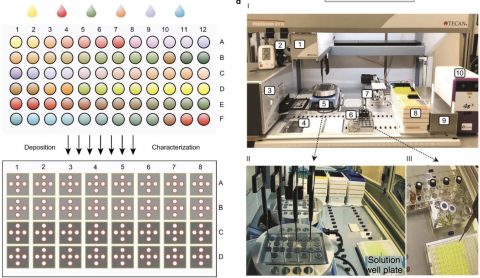Yicheng’s article on high-throughput robotic learning of hybrid perovskite materials featured by the Nature Communications!
Yicheng’s article “Discovery of temperature-induced stability reversal in perovskites using high-throughput robotic learning” published in Nature Communications is highlighted as the Featured article! The Editors’ Highlights pages aim to showcase the 50 best papers recently published in an area.
Yicheng et al. use a high-throughput robotic platform, combined with machine learning, such as correlation analysis, model regression and SHAP evaluation to study the stability of organic-inorganic hybrid perovskite materials with mixed cations (K/Rb/Cs/MA/FA-PbI3). The effect of the ratio of organic cations (MA/FA) and inorganic cations (Cs/Rb) on the stability of chalcogenide was found to be significantly dependent on the aging temperature. At high temperatures (> 100 °C), the doping of inorganic cations improves the photothermal stability of the films, while the doping of organic cations reduces the photothermal stability of the films; at low temperatures (< 100 °C), this effect is evidently reversed. Further theoretical studies show that this stability inversion is caused by differences in the kinetic constants and kinetic activation energies in decomposition. Since the majority of perovskite-based devices operate at <100 °C, it is recommended that photothermal stable FAPbI3-based perovskite materials should be doped with at least 10 mol.% MA and at most 5 mol.% Cs/K/Rb.

